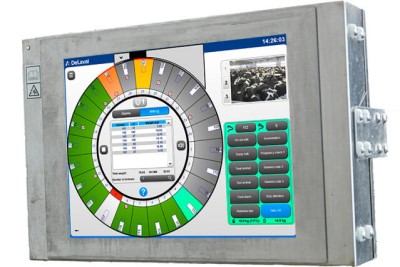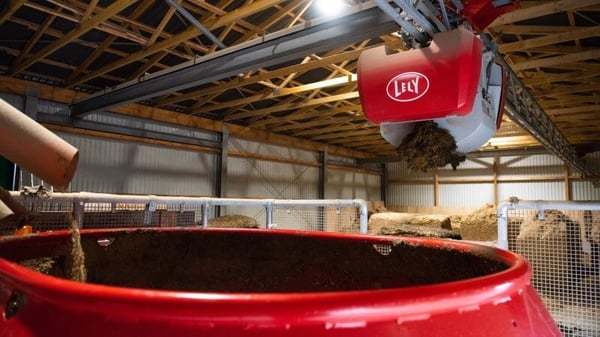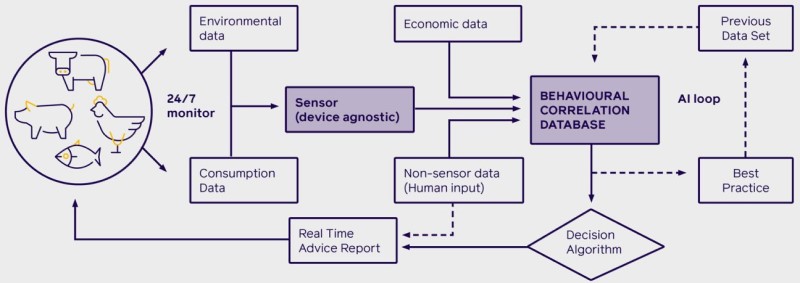Precision livestock farming uses real-time monitoring and management systems to optimise productivity, animal welfare and sustainability on farms. It analyses data to help farmers make better informed decisions, which brings benefits to the farmers, their livestock, consumers and the environment.
This blog looks at 12 precision livestock farming companies – some large, some small – that are leading the way in developing agtech innovations.
Why is precision livestock farming important?
Currently, the farming sector is looking for ways to increase both productivity and standards. This is in the face of increasing demand because of population growth, which is predicted to rise from 8 billion in 2022 to 9.7 billion by 2050. Alongside this, there’s growing awareness of issues around environmental sustainability and animal welfare.
So, farmers need to work smarter to meet these challenges, which is where the use of agtech innovations – such as precision livestock farming – come into their own.
What is precision livestock farming?
Put simply, it means using data to identify how to farm livestock more efficiently. The data is collected via real-time monitoring and management systems that are used for routine tasks, such as milking and feeding, and also for general health monitoring. These systems rely on advanced technologies like sensors, data analytics and automation, all connected in a complex network.
Milking robots use smart technology to create a calm and relaxed milking process. This environment increases milk yields and efficiency, with clear financial benefits to the farmer.
Precision feeding systems allow feed to be delivered at specific times and in specific amounts. This is advantageous for animal health, as well as reducing feed wastage and labour costs.
Health monitoring systems automatically measure and record specific metrics for an animal, such as weight, temperature, behaviour, respiration and gait. By doing so, the farmer can be alerted to any unexpected changes in the animal’s wellbeing and then take appropriate action – this timely intervention greatly increases the chances of success of the action.
DeLaval (Sweden)
Like many precision livestock farming companies, DeLaval offers solutions for automated milking and feeding, such as identification and tracking, milk point controllers, and milk meters. The company’s DelPro™ Farm Management Platform processes and analyses all the data about a herd to create actionable reports.
 Source: DeLaval
Source: DeLaval
GEA Group (Germany)
The GEA DairyRobot R9500 Robotic Milking System is one example of the milking, feeding, herd management and hygiene products sold by GEA Group. This robot combines automation with digitalisation, resulting in reduced water and energy consumption, detergent use, and milking times. It also uses a cell count sensor to detect mastitis infections in cows as early as possible.
GEA FarmView monitoring software makes it easy to manage the milking robot and optimise performance parameters during operation.
Lely International (Netherlands)
Lely International provides many solutions in milking, feeding, and housing and caring. It also has a large focus on smart technology and data with its Lely Horizon software. This system “uses smart algorithms based on experiences of thousands of dairy farmers worldwide. The farm management application elevates your data to forecast performances and offers you clear choices for farming optimisation.”
 Source: Lely
Source: Lely
Afimilk (Israel)
Afimilk specialises in:
- Cow monitoring – using neck and leg collars.
- Farm management software – such as AfiFarm 5.5 “for effective management of animal inventory, problem detection (like sick animals or the wrong group) and intervention, milking, health and fertility monitoring”.
- Parlour automation – using milk meters, analysers and pedometers (for accurate heat detection, calving alerts, rest monitoring and animal identification).
- Data management and analysis – such as cloud-based applications and backup storage.
BouMatic (US)
BouMatic provides a wide range of products, covering milking, cleaning in place (CIP), cooling, manure handling, hygiene and other areas. For example, its Gemini UP milking robots feature a time-of-flight camera to determine the exact position of individual teats. As the attachment approaches the cow, “it conducts a 3D analysis of the teats, identifying the location more accurately.”

Source: Boumatic
Allflex Livestock Intelligence (US)
Animal tracing and identification solutions are the focus of Allflex Livestock Intelligence. On farms, visual tags, tissue sampling tags and collectors, and radio frequency tags (RFID) are used to participate in product branding programmes. These devices, along with the associated applicators and readers, also ensure compliance with regulatory traceability and biosecurity programmes.
In addition, data provided by these tags is used to boost productivity and make informed decisions about herd health.
Farm4Trade (Italy)
Farm4Trade uses AI and digital productivity tools to enhance livestock farming. According to the company, “Farm4Trade is creating a new way of harvesting and analysing animal data. The farmer becomes the leading actor of the farming system and participates in the enabling process of data collection to gather geo-referenced information that can be analysed and used to improve livestock production systems globally.”
The outcome is an integrated suite of tools for use throughout the production process. It enables data analysis, custom queries and predictions, all of which contribute towards greater productivity.
Kraal (UK)
Kraal is another company with a strong focus on smart technology and data. It combines farm data with scientific and mathematical models to form a very detailed knowledge of each animal.
More specifically, the website states: “Our digital, solar powered, GPS ear tag, easily fitted with a normal applicator, continuously tracks the location of your livestock over long distances. Our powerful cloud platform and operating system take data from the ear tag, augments it with AI, machine learning and multi-source data and present insights at individual and herd level. You can monitor your livestocks’ wellbeing and health and will receive alerts of any livestock at risk.”
Optifarm (UK)
Optifarm also uses AI to understand farm data, alongside an interface that helps to implement and track corrective actions. The aim is to create value across the entire supply chain. The AI sends alerts when deviations arise, which it can also investigate to try to find the root cause of.
 Source: Optifarm
Source: Optifarm
LIC (New Zealand)
LIC is slightly different in that it specialises in artificial breeding, not just herd management, testing and health. The company’s herd management platform, MINDA®, analyses and reports on animal data gathered from shed automation and technology that is worn by the cow. The aim is to provide farmers with “precision genetics and technology tools to improve their herds and be more sustainable.”
Fancom (Netherlands)
Fancom designs intelligent automation solutions for pig, poultry and mushroom farming, with an emphasis on superior housing conditions.
Fancom One is a smart farming system for complete farm automation. It offers “smart house technology that monitors and regulates all the integral processes from one central location, [enabling] our customers to produce more efficiently and profitably in a way that respects animal welfare and the environment.”
Fullwood JOZ (UK)
Fullwood JOZ specialises in robotic milking and herd management. Its wearable neck and leg sensors are designed to identify any health issues in the early stages, for greater cow welfare and improved herd management. This is supported by its MerlinView software and M²erlinInfo app, to provide complete visibility of the milking system on a farm.
The company also states: “We believe that comfortable cows are productive cows. Our unique approach puts cow comfort first, resulting in better milking, improved health, and increased yields. We use smart technology, with valuable real-time data at your fingertips, to keep your milking stress-free and profitable. Smart milking unlocks the full potential of your milking environment.”
Future directions in precision livestock farming?
According to PR Newswire, milking robotic systems are predicted to hold the largest market share in precision livestock farming between 2023 and 2028. This is because of the expected sustained increase in demand for high-quality dairy products.
However, applications to monitor livestock health and behaviour are expected to see the highest growth rate between 2023 and 2028. Finally, robotics hardware, RFID tags and sensors are likely to contribute a significant share in the market during the same period.
The companies described above are all likely to be leading the way in this revolution, helping livestock farmers to operate smarter and more productively.

